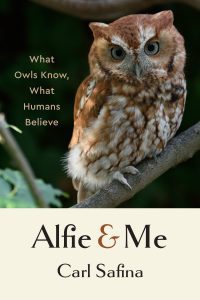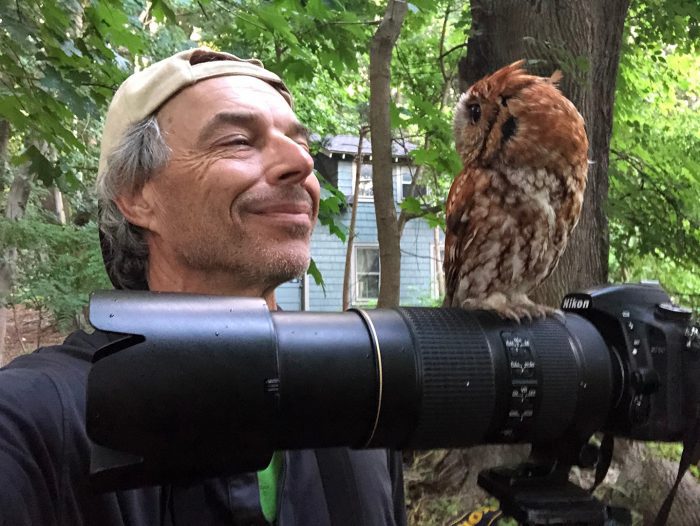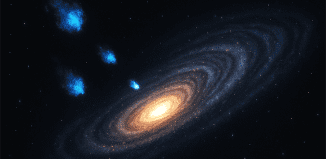Book Review: ‘Alfie & Me: What Owls Know, What Humans Believe’
Reviewed by John L. Turner
Perhaps it’s due to an owl’s forward facing eyes, imparting a humanlike aspect to its face, that is the source of the long-held belief that owls possess great wisdom and intelligence. Actually other birds, most notably members of the crow family like ravens, crow, and blue jays do best in intelligence tests but you wouldn’t know it from the photo of Alfie, a screech owl, that adorns the cover of Carl Safina’s new book Alfie & Me: What Owls Know, What Humans Believe. With an intense stare suggesting human level concentration possessing sickle shaped talons clutching the branch, Alfie is a vibrantly alive bird, an impressive predator that fully “knows” how to be an owl.
The book involves the author raising a young screech owl dealt a terrible hand that would have been a fatal one were it not for the intervention of the author. Along the way Alfie learns to become more independent, finds a mate and raises a family of three.

What becomes immediately clear and what I did not know despite being neighbors and friends of Carl and Patricia, but what I should have known given their abiding and deep interest in the natural world, is just how much time they spent closely watching Alfie reach her potential, blossoming into a fully functioning adult owl, one member of a five member family — all during the COVID pandemic.
They both, but especially Carl, spent what must be hundreds of hours observing Alfie. And as a reader of the book will soon discover, this world enlarges with the appearance of her mate Plus-One and the logical results of Plus-One appearing on the scene — three young baby screech owls. These babies, individually and together, are variously described as: “little spheres of fluffiness,” “a fat ball of a baby,” and a “fluff-jacketed cutie.” The quintet were named “The Hoo,” who together “remained down-jacketed, fluffy, light as the clouds above them.”
In this way the book is a classic story of a scientist delving deeply into the world of a wild animal, along the lines of Douglas Chadwick’s The Wolverine Way, Bernd Heinrich’s Mind of the Raven or Maria Mudd Ruth’s detailed study of the Marbled Murrelet in Rare Bird. There’s exploration and analysis, observation and interpretation, study and understanding, and most importantly the development of a strong relationship.
What’s unique in Alfie & Me is this all takes place in an acre or so around their suburban home, and within that area most within a 50-foot envelope around the house. This story, the development of an intimate “around the house” wild bird-human relationship, ties Alfie & Me with Julie Zickefoose’s Saving Jemima, in which the author spends a good part of a year raising a blue jay to health and independence. There are many delightful parallels between the two books.
Unlike Safina’s earlier books like Song for a Blue Ocean, A Sea in Flames, Voyage of the Turtle, and Eye of the Albatross, Alfie & Me, is more of an extension of, and elaboration upon, some of the concepts advanced in Safina’s three most recent books: The View from Lazy Point, Becoming Wild and Beyond Words: What Animals Think and Feel. These later books explore the intellectual, emotional, and sensory world of animals, their societies and culture, and complexities in the relationship and attitudes of humans with other life forms, specifically, and the natural world generally.
A fundamental aspect of the book is, of course, the interspecies relationship between a few humans and a few owls with colorful side notes on a few dogs and a flock of chickens; an overlapping connection between the one world of the two species, the author aptly emphasizing Alfie being able to place “a wing in ours, I, with a foot in hers.” Or “….the ability to walk the bridge Alfie had opened between their world and ours.”
 The Eastern Screech Owl (Megascops asio) is one of two common woodland owls that find breeding habitat here on Long Island. Along with their much larger cousin, and sometimes mortal enemy the Great Horned Owl (Bubo virginianus), Screech Owls are surprisingly common in forests both large and small. Even parcels as small as ten acres are likely to host a breeding pair. Less common woodland owls here include Saw-whet (Aegolius acadicus) and Long-eared Owls (Asio otis) “whoo” are joined by open country visitors during the winter months — Snowy Owls (Bubo scandiacus) and Short-eared Owls (Asio flammeus), coastal and grassland inhabitants respectively.
The Eastern Screech Owl (Megascops asio) is one of two common woodland owls that find breeding habitat here on Long Island. Along with their much larger cousin, and sometimes mortal enemy the Great Horned Owl (Bubo virginianus), Screech Owls are surprisingly common in forests both large and small. Even parcels as small as ten acres are likely to host a breeding pair. Less common woodland owls here include Saw-whet (Aegolius acadicus) and Long-eared Owls (Asio otis) “whoo” are joined by open country visitors during the winter months — Snowy Owls (Bubo scandiacus) and Short-eared Owls (Asio flammeus), coastal and grassland inhabitants respectively.
And unique to the owl species found in eastern North America, screech owls come in two color forms or morphs. Alfie and Plus-One are red or rufous morph individuals which is the more common form on Long Island. Or as Safina notes “a magical russet comet.” The grey form, however, is more common throughout the species range.
Safina is a highly gifted writer, quite adept at turning a phrase and the book is replete with colorful imagery and strong sentences, to wit: “I have always felt that my generation existed in a time spanning the last good years and the beginning of the end of the world,” “The air was stock still. Leafy canopies of maples and the spires of cedars formed a denser darkness against the star-studded vault of space”, and “If they fell to the ground, they’d still climb straight up a trunk, but they were also realizing that crossing distances involved flapping their interesting upper limbs. In a way, they were finding their inner owl.”
This book would be a worthwhile read if all it presented was a highly articulate description of screech owls and their behavior and ecology. But it’s so much more. Alfie provides a feathered springboard for the author to discuss how western thought, espoused by western thought leaders (think Descartes, Bacon, Dawkins, et al.) has led to the dangerous result and our current predicament where so many members of human society are estranged from animals and nature with the resultant deterioration of the global environment. Their “reductionist” thinking of animals as being nothing more than soulless machines incapable of thoughts, emotions, even the ability to feel pain, was all pervasive resulting in the view that humans commanded a lofty and unique perch above lowly forms of life that gave them full dominion over all animals.
In contrast, Safina documents, Eastern and North American Indigenous cultures and religions held views that better harmonized humankind with the animal kingdom and the natural elements of the world. A world with more passion and less consumption. Clearly, the book is an exploration of proffered beliefs, strongly held.
This book also is an exultation of life and living things, a fundamentally and qualitatively unique aspect in this otherwise lifeless universe, a concept that Safina notes and embraces and Alfie illustrates. Life is something worth celebrating, cherishing, and protecting. “The owls gave us the opportunity to pay attention. That was their main gift to us: to be present for a while in the always magical here and now.”
Through Safina’s prose we all can take delight in his decision to intercede and change what was clearly a fatal trajectory for Alfie. We are all the richer for his intervention. Safina ends: “It was amazing how quiet and empty the air could feel once you subtracted owls. But now I knew they were out there, livening up the nights with or without me. Yes, I felt an empty nester. But I’d been dealt a full house, a winning hand.”
Both Carl and Alfie have a lot to say. And we gain pleasure in listening. Alfie & Me is a most important book and a most compelling and worthwhile read — we too have been dealt a winning hand.







